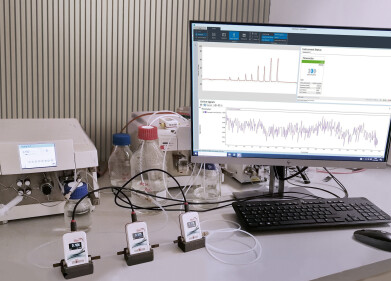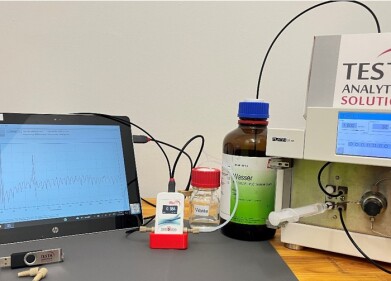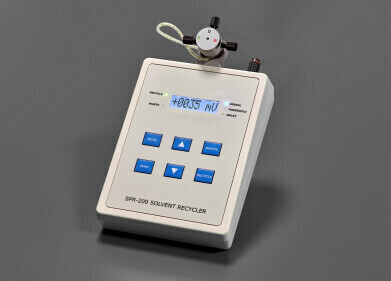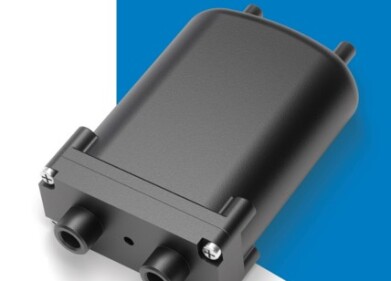-
 Shimadzu custom GC expert Peter Klawitter with one of the team’s bespoke instruments for the analysis of permanent gases. Like many such systems, this one is based on a Shimadzu GC-2030.
Shimadzu custom GC expert Peter Klawitter with one of the team’s bespoke instruments for the analysis of permanent gases. Like many such systems, this one is based on a Shimadzu GC-2030. -
 The custom GC systems designed by the Shimadzu team vary in complexity. This is one of the more intricate designs, involving two valves, three columns, and three detectors.
The custom GC systems designed by the Shimadzu team vary in complexity. This is one of the more intricate designs, involving two valves, three columns, and three detectors. -
 Example of an analysis conducted using a custom GC system, which in this case uses three sample loops. After backflushing off the C6+ components as one peak, C1–C5 hydrocarbons are directed to an alumina capillary column, with all the components then detected by FID. Meanwhile, H2, O2, N2, CH4 and CO are separated on an MS-5A column, while CO2, C2H4, C2H6, C2H2 and H2S are separated by Rtx-Q plot, with both separations detected using BID. The final analysis time is just 5.5 minutes. For full details please see Application Data Sheet No. 126.
Example of an analysis conducted using a custom GC system, which in this case uses three sample loops. After backflushing off the C6+ components as one peak, C1–C5 hydrocarbons are directed to an alumina capillary column, with all the components then detected by FID. Meanwhile, H2, O2, N2, CH4 and CO are separated on an MS-5A column, while CO2, C2H4, C2H6, C2H2 and H2S are separated by Rtx-Q plot, with both separations detected using BID. The final analysis time is just 5.5 minutes. For full details please see Application Data Sheet No. 126. -
 Close-up of the custom GC valving and flowpaths in place on top of the GC, which allows space on the side for an MS detector, if needed.
Close-up of the custom GC valving and flowpaths in place on top of the GC, which allows space on the side for an MS detector, if needed.
Chromatography
Custom GC helps researchers tackle the energy crisis
Jul 28 2022
Despite the versatility of GC systems and columns available off-the-shelf, the GC analysis of permanent gases remains a specialist field requiring a more bespoke approach. We talk to Peter Klawitter, who for over 15 years has been the in-house expert on these custom GC instruments at Shimadzu UK. As well as hearing from him what’s involved in designing these systems, we discover why these bespoke GC systems are proving so useful in the rapidly growing research field of ‘new energy’.
Hello Pete! Can you start by describing what you do in the custom GC group at Shimadzu?
Thanks for the opportunity to talk! In our group, we devise, build and sell bespoke GC systems to the UK market. These are mostly for analysis of commonly-encountered permanent gases such as hydrogen, oxygen, nitrogen, methane, carbon dioxide and carbon monoxide, but we also deal with some of the more obscure gases such as ammonia and nitrous oxide.
We’ve grown substantially since I started at Shimadzu in 2003, and we’ve now got about 70 systems installed in the UK. Many of these are in university labs - and that’s actually where much of our current focus lies in terms of new systems.
Why are custom GC systems needed? Isn’t it possible to devise a ‘one-size-fits-all’ solution for gas analysis?
That’s a fair point. Unlike the VOCs and SVOCs analysed by standard GC systems, permanent gases have a much greater variety of physical and chemical characteristics – what we call ‘chemistries’. These really complicate separation and detection, and limit the types of columns we can use. For example, CO2 poisons the commonly used molecular sieve columns, while FID detection won’t work for anything without a hydrocarbon bond in.
Ammonia is a tricky one as well, as it’s pretty aggressive and so needs to be split off into its own detection and analysis line. And in the most challenging situations involving sulphur species, we have to refit the internals of the GC with specially treated alloys to stop the samples ‘sticking’ to the components!
As a result of all this, you typically need multiple columns and detectors for gas analysis, as well as valving to separate out the target species, and carefully-considered valve flows and timings to ensure optimum performance. Essentially, this means that each time a customer comes to us with an application request, we need to create a customised GC system for them.
Apart from analyte chemistry, what other considerations are there in designing a new system?
A major factor is the analyte level we’re looking at. If the customer just wants to detect at levels of say 0.1% and above, then a thermal conductivity detector (TCD) is usually fine. But even then, we might have to think about the carrier gas, because TCDs can’t distinguish between hydrogen and helium. And of course we need to consider whether the detector might be overloaded by high-abundance compounds, and so require the flow to be split. On the other hand, when the customer needs low detection limits, which is happening quite a lot now especially with our customers in academia, we’ll need a more sensitive detector.
But ultimately, we make our system designs as simple as we can, and deal with the necessary complexity as far as possible through the method. That way, our customers get the best system robustness, performance and flexibility.
When you build the custom GCs, do you start from a standard GC system?
Yes, the core frame for the majority of our builds is the Shimadzu Nexis GC-2030, which is great for custom work because it allows all our additional valving to be fitted on top of the instrument. This frees up the left-hand side of the GC for coupling to an MS detector, which is very handy for applications involving isotope work.
And as for detection, I’ve already mentioned TCD, but there’s also FID for hydrocarbons and ECD for nitrous oxide. Plus of course we have our own patented barrier ionisation detector or BID, which we released back in 2014, and which offers much lower detection limits for the permanent gases.
That sounds like a really useful development for custom GC. How does it work?
Yes, it’s been a game-changer for us really. At the heart of the BID is a quartz dielectric chamber, which generates a helium plasma that ionises pretty much everything that elutes from the GC. What makes the BID different from previous helium ionisation detectors is that the electrodes have a dielectric coating, preventing the plasma from eating away at them, and giving the detector much higher precision and excellent long-term stability.
But the main benefit for the analyst is the lower detection limits - BID is 100 to 200 times as sensitive as TCD! When specifying systems for customers, I usually quote down to about 30 ppm for most of the permanent gases, but you can fairly easily get lower than that by optimising the method once the system’s up and running. We can also equip the Nexis GC-2030 with two BID detectors to get more out of each analysis.
What are the main applications for custom GC?
The applications have changed a lot over the years. Initially we were focused on analysing refinery gases, and I think the first job we ever did was for liquified natural gas. In fact, that application became so popular that it stopped being a custom build and became a prebuilt off-the-shelf product.
But now, about 80% of the systems we’re selling are for ‘new energy’ applications, with our primary customers being in academia. For example, we’re delivering systems to analyse methane and other gases generated from catalytic or light-mediated reduction of CO2, or for generating hydrogen from hydrocarbons for use in fuel cells. So, the thrust of the research is all about diversifying our energy sources and becoming less carbon-intensive in how we generate energy.
That’s obviously a hot topic at the moment given the current problems with energy supply. When did interest in using custom GC in this field get going?
Here in the UK, it started about seven years ago with one or two groups – but it’s swiftly expanded to about 12 groups today. A main driver has been the generous funding that’s been available for this sort of research, which naturally has spurred a lot of groups to investigate it.
What’s interesting from the instrument point of view is the degree of ‘cross-pollination’ between researchers. One of the first academic groups who we sold a custom GC to was the Reisner group at Cambridge University, swiftly followed by University College London and Imperial College London. They produced papers citing the use of our GC with the BID detector, and then we found other groups got in touch wanting to set up a similar system for their work.
What are the main challenges presented by such applications?
A common theme through much of this research into ‘new energy’ is quantifying gases at a wide range of levels in one sample. For example, as well as bulk amounts of the gas you’re synthesising, you may be looking for trace levels of impurities. Determining these values is vital for optimising a process and making the end product as pure as possible – which is obviously vital if it’s going to be used on an industrial scale.
Another related application that has the same challenge is analysis of greenhouse gases such as CO2, methane and nitrous oxide - again requiring determination of levels from low percent down to parts per billion, all in one analysis. Having the BID detector has really opened up these applications to us, because it allows us to get down to the really low levels that researchers want.
How does this compare to other systems on the market?
Well, it’s different ball game, as they say. For example, many people are still using packed columns for gas analysis, which are fine for some purposes, but we’ve largely moved over to capillary columns now. The obvious benefits are better separation with faster runs, but they also work with smaller samples, which of course is perfect for lab-scale research. If customers have had previous experience with packed columns for gas analysis, then they’re usually pretty impressed by what can be achieved with capillary systems, especially in conjunction with the BID detector.
And in terms of the overall service that you offer, what makes customers come back to you?
I think it’s really the bespoke service and the expertise we have - you don’t get that with every supplier. We’ve been doing custom GC at Shimadzu for nearly 20 years now, so we’ve accumulated a lot of knowledge about how to design systems for pretty much every situation, and customers really appreciate that. But there are always new challenges, and what’s great about many of our customers is that they’re always looking to push the boundaries of what’s possible, which keeps us on our toes!
Looking to the future, we’ve built up a great team here now, with a couple of specialists that I’ve trained up to know the ins and outs of the custom GC systems and the applications. Like me, they’re basically engineers with an analytical chemistry background, so they’ve got the fundamental understanding of the chemistry needed to understand the customer’s requirements, design systems the best way, and test them in our demo lab. And we pre-define the methods for our customers too, so once the system is installed and the customer has received training in the software, they can be up and running very quickly.
To wrap things up, what do you love most about working for Shimadzu?
That’s a good question! I think it’s really the ability to help people, and the satisfaction you get from successfully carrying out a challenging project. I’m a problem-solver at heart, and I love getting stuck into a new challenge and seeing it through to completion.
For example, an application we worked on recently was particularly tricky because the customer wanted to detect low-ppm levels of permanent gases produced by a very small reaction cell. It took a while to design and optimise the system, but they’re very happy now. And that’s rewarding in itself, but of course it’s even better because we know we’re ultimately helping research into technologies that will provide a greener and more secure energy supply for future generations.
Thanks for your time Pete, and for explaining about your custom GC work – it’s been very interesting.
No problem, it’s been a pleasure to talk to you!
Biography: Peter Klawitter originally trained as an analytical chemist, and then spent time in the pharmaceutical and service lab sectors, following which he became a service engineer for Spectra Physics Analytical (later acquired by Thermo Electron). Then in 2003 he joined Shimadzu, initially working as an LC engineer, but soon focusing on designing and assembling their bespoke GC systems - a role he’s been in ever since.
Digital Edition
Lab Asia 31.6 Dec 2024
December 2024
Chromatography Articles - Sustainable chromatography: Embracing software for greener methods Mass Spectrometry & Spectroscopy Articles - Solving industry challenges for phosphorus containi...
View all digital editions
Events
Jan 22 2025 Tokyo, Japan
Jan 22 2025 Birmingham, UK
Jan 25 2025 San Diego, CA, USA
Jan 27 2025 Dubai, UAE
Jan 29 2025 Tokyo, Japan


















